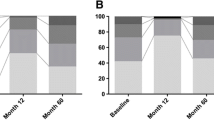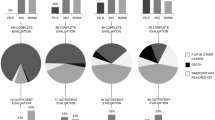Abstract
Subthalamic nucleus deep brain stimulation (STN-DBS) has been proven to improve health-related quality of life (HRQoL) in patients with Parkinson’s disease (PD) presenting medically refractory motor complications and dyskinesia. However, some patients fail to benefit from STN-DBS despite rigorous preoperative selection. We postulated that they have a particular, clinically ineloquent, brain metabolism before surgery. We divided 40 stimulated PD patients into two groups (responders vs. nonresponders) depending on whether they reported or not a clinically significant improvement in their quality of life 1 year after surgery. We retrospectively compared their preoperative brain metabolism on the basis of 18F-fluorodeoxyglucose positron emission tomography (18F-FDG PET) scans. We also analyzed their neuropsychological and psychiatric profiles before and after surgery. All 40 patients met the STN-DBS selection criteria, but only 50 % of them had significantly improved 1 year after surgery. Preoperative PET scans showed that metabolism was higher in the left insula, both inferior frontal gyri and left precentral gyrus in nonresponders than in responders. Clinically, postoperative motor scores were similar in both groups, but a worsening of the depression score was observed among nonresponders. PET imaging revealed that nonresponders were characterized by distinctive brain functioning pre-surgery, in regions involved in associative and limbic circuits, as a result of PD-related degeneration. STN-DBS may have interfered with this already abnormal circuitry, leading to the occurrence of complex nonmotor symptoms reducing quality of life. Preoperative brain metabolism could be a useful biomarker for anticipating STN-DBS efficacy in terms of HRQoL in the context of advanced PD.

Similar content being viewed by others
References
Bronstein JM, Tagliati M, Alterman RL et al (2011) Deep brain stimulation for Parkinson disease: an expert consensus and review of key issues. Arch Neurol 68:165. doi:10.1001/archneurol.2010.260
Limousin P, Krack P, Pollak P et al (1998) Electrical stimulation of the subthalamic nucleus in advanced Parkinson’s Disease. N Engl J Med 339:1105–1111. doi:10.1056/NEJM199810153391603
Chaudhuri KR, Healy DG, Schapira AH (2006) Non-motor symptoms of Parkinson’s disease: diagnosis and management. Lancet Neurol 5:235–245. doi:10.1016/S1474-4422(06)70373-8
Temel Y, Kessels A, Tan S et al (2006) Behavioural changes after bilateral subthalamic stimulation in advanced Parkinson disease: a systematic review. Parkinsonism Relat Disord 12:265–272. doi:10.1016/j.parkreldis.2006.01.004
Schrag A, Jahanshahi M, Quinn N (2000) What contributes to quality of life in patients with Parkinson’s disease? J Neurol Neurosurg Psychiatry 69:308–312
Martínez-Martín P (1998) An introduction to the concept of “quality of life in Parkinson’s disease”. J Neurol 245(Suppl 1):S2–S6
Martinez-Martin P, Jeukens-Visser M, Lyons KE et al (2011) Health-related quality-of-life scales in Parkinson’s disease: critique and recommendations. Mov Disord 26:2371–2380. doi:10.1002/mds.23834
Kleiner-Fisman G, Herzog J, Fisman DN et al (2006) Subthalamic nucleus deep brain stimulation: summary and meta-analysis of outcomes. Mov Disord 21(Suppl 14):S290–S304. doi:10.1002/mds.20962
Drapier S, Raoul S, Drapier D et al (2005) Only physical aspects of quality of life are significantly improved by bilateral subthalamic stimulation in Parkinson’s disease. J Neurol 252:583–588. doi:10.1007/s00415-005-0704-4
Hughes AJ, Daniel SE, Kilford L, Lees AJ (1992) Accuracy of clinical diagnosis of idiopathic Parkinson’s disease: a clinico-pathological study of 100 cases. J Neurol Neurosurg Psychiatry 55:181
Deuschl G, Schüpbach M, Knudsen K et al (2013) Stimulation of the subthalamic nucleus at an earlier disease stage of Parkinson’s disease: concept and standards of the EARLYSTIM-study. Parkinsonism Relat Disord 19:56–61. doi:10.1016/j.parkreldis.2012.07.004
Langston JW, Widner H, Goetz CG et al (1992) Core assessment program for intracerebral transplantations (CAPIT). Mov Disord 7:2–13. doi:10.1002/mds.870070103
Mattis S (1988) Dementia rating scale professional manual. Psychological Assessment Resources Inc., Odessa, FL
Stroop JR (1935) Studies of interferences in serial verbal reactions. J Exp Psychol 18:643–662
Reitan R (1958) Validity of the Trail Making Test as an indicator of organic brain damage. Percept Mot Ski 8:271–276. doi:10.2466/PMS.8.7.271-276
Nelson HE (1976) A modified card sorting test sensitive to frontal lobe defects. Cortex 12:313–324. doi:10.1016/S0010-9452(76)80035-4
Cardebat D, Doyon B, Puel M et al (1990) Evocation lexicale formelle et sémantique chez des sujets normaux. Performances et dynamiques de production en fonction du sexe, de l’âge et du niveau d’étude. Acta Neurol Belg 90:207–217
Montgomery SA, Asberg M (1979) A new depression scale designed to be sensitive to change. Br J Psychiatry J Ment Sci 134:382–389
Marin RS, Biedrzycki RC, Firinciogullari S (1991) Reliability and validity of the apathy evaluation scale. Psychiatry Res 38:143–162. doi:10.1016/0165-1781(91)90040-V
Peto V, Jenkinson C, Fitzpatrick R (1998) PDQ-39: a review of the development, validation and application of a Parkinson’s disease quality of life questionnaire and its associated measures. J Neurol 245(Suppl 1):S10–S14
Peto V, Jenkinson C, Fitzpatrick R (2001) Determining minimally important differences for the PDQ-39 Parkinson’s disease questionnaire. Age Ageing 30:299–302
Cohen J (1988) Statistical power analysis for the behavioral sciences, 2nd edn. Lawrence Erlbaum Associates
Daniels C, Krack P, Volkmann J et al (2011) Is improvement in the quality of life after subthalamic nucleus stimulation in Parkinson’s disease predictable? Mov Disord 26:2516–2521. doi:10.1002/mds.23907
Floden D, Cooper SE, Griffith SD, Machado AG (2014) Predicting quality of life outcomes after subthalamic nucleus deep brain stimulation. Neurology 83:1627–1633. doi:10.1212/WNL.0000000000000943
Martínez-Martín P, Rodríguez-Blázquez C, Forjaz MJ et al (2014) Relationship between the MDS-UPDRS domains and the health-related quality of life of Parkinson’s disease patients. Eur J Neurol. doi:10.1111/ene.12349
Soh S-E, Morris ME, McGinley JL (2011) Determinants of health-related quality of life in Parkinson’s disease: a systematic review. Parkinsonism Relat Disord 17:1–9. doi:10.1016/j.parkreldis.2010.08.012
Barone P, Antonini A, Colosimo C et al (2009) The PRIAMO study: a multicenter assessment of nonmotor symptoms and their impact on quality of life in Parkinson’s disease. Mov Disord 24:1641–1649. doi:10.1002/mds.22643
Huang C, Tang C, Feigin A et al (2007) Changes in network activity with the progression of Parkinson’s disease. Brain 130:1834–1846. doi:10.1093/brain/awm086
Benzinger TLS, Blazey T, Jack CR Jr et al (2013) Regional variability of imaging biomarkers in autosomal dominant Alzheimer’s disease. Proc Natl Acad Sci USA 110:E4502–E4509. doi:10.1073/pnas.1317918110
Luo F, Rustay NR, Ebert U et al (2012) Characterization of 7- and 19-month-old Tg2576 mice using multimodal in vivo imaging: limitations as a translatable model of Alzheimer’s disease. Neurobiol Aging 33:933–944. doi:10.1016/j.neurobiolaging.2010.08.005
Biundo R, Calabrese M, Weis L et al (2013) Anatomical correlates of cognitive functions in early Parkinson’s disease patients. PLoS One 8:e64222. doi:10.1371/journal.pone.0064222
Tucker AM, Stern Y (2011) Cognitive reserve in aging. Curr Alzheimer Res 8:354–360
Le Jeune F, Péron J, Grandjean D et al (2010) Subthalamic nucleus stimulation affects limbic and associative circuits: a PET study. Eur J Nucl Med Mol Imaging 37:1512–1520. doi:10.1007/s00259-010-1436-y
Robert G, Le Jeune F, Lozachmeur C et al (2012) Apathy in patients with Parkinson disease without dementia or depression: a PET study. Neurology 79:1155–1160. doi:10.1212/WNL.0b013e3182698c75
Benoit M, Robert PH (2011) Imaging correlates of apathy and depression in Parkinson’s disease. J Neurol Sci 310:58–60. doi:10.1016/j.jns.2011.07.006
Fitzgerald PB, Laird AR, Maller J, Daskalakis ZJ (2008) A meta-analytic study of changes in brain activation in depression. Hum Brain Mapp 29:683–695. doi:10.1002/hbm.20426
Mertens TE (1993) Estimating the effects of misclassification. Lancet 342:418–421
Bland JM, Altman DG (1994) Some examples of regression towards the mean. BMJ 309:780
Acknowledgments
The authors would like to thank all the members of the neurology department for their help in gathering and collating the data.
Conflicts of interest
The authors declare that they have no conflict of interest.
Ethical standard
Written informed consent was obtained from each participant, and the study met the ethical standards of the institutional ethical standards committee on human experimentation.
Author information
Authors and Affiliations
Corresponding author
Electronic supplementary material
Below is the link to the electronic supplementary material.
Rights and permissions
About this article
Cite this article
Langner-Lemercier, S., Drapier, S., Naudet, F. et al. Preoperative brain metabolism and quality of life after subthalamic nucleus stimulation in Parkinson’s disease. J Neurol 262, 881–889 (2015). https://doi.org/10.1007/s00415-015-7647-1
Received:
Revised:
Accepted:
Published:
Issue Date:
DOI: https://doi.org/10.1007/s00415-015-7647-1




